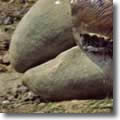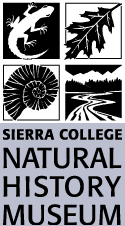Art the Whale
By Gary Noy
Reprinted from Sierra Heritage, March-April 1989
Used by permission of the author
A mysterious body
 A body floats up on the beach. It is discovered, identified, and found to have eight aliases. The body is dismembered, crudely jammed into dirty barrels, roughly tossed into the back of a truck, and buried in the dead of night by the light of automobile headlamps. Neighbors hear strange noises, and smell even stranger odors. Vats of unidentified liquid boil ominously at the site. Multinational corporations and government officials are involved. Eleven months pass. The body is exhumed and reassembled. Scientists look with delight at their reconstructed creature.
A body floats up on the beach. It is discovered, identified, and found to have eight aliases. The body is dismembered, crudely jammed into dirty barrels, roughly tossed into the back of a truck, and buried in the dead of night by the light of automobile headlamps. Neighbors hear strange noises, and smell even stranger odors. Vats of unidentified liquid boil ominously at the site. Multinational corporations and government officials are involved. Eleven months pass. The body is exhumed and reassembled. Scientists look with delight at their reconstructed creature.
A scene from Frankenstein or perhaps the opening lines of a macabre Edgar Allen Poe short story? No, it is the true story of Art the Whale, centerpiece exhibit at the Sierra Natural History Museum.
California Gray Whale, Eschrichtius robustus
The California Gray Whale exhibit is but one of many found at the museum, rated by experts as an outstanding regional natural history center. Co-directed by Sierra College instructors Charles Dailey and Dick Hilton, the Museum has provided educational opportunities to tens of thousands of students, area residents, and the curious. It offers animal displays, nature trails, arboretums, and hands-on experiences for every age.
"Art is our main attraction," says Dailey, a zoology instructor and avid collector of skeletal remains and fossils. "We envision Art the Whale as a teaching tool and public attraction that will lead to expansion and improvement of our Science Center."
Art died in 1986, but that was just the beginning
In May 1986, a 40-foot California Gray Whale was found dead under a pier in Benecia. Dailey acquired title to the body from the National Marine Fisheries, and the U.S. Navy towed the carcass to the local county dump. He and 20 students spent a day dismembering the whale for transport. Although traditional whale knives, called flensing knives, were used, the task was mainly accomplished by common kitchen knives. The smelly, oily parts were loaded onto a pickup truck, and the journey back to Rocklin began. Clothing worn during the phase had to be destroyed as the smell could not be removed.
"One funny incident occurred when we approached a weigh station near Fairfield," Dailey recalls. "I'm not sure if the officials at the station smelled us coming, but when we arrived at the station, they waved us through immediately. I don't think we even slowed down."
A slide show prepared by Dailey features the amusing and somewhat disgusted expressions of other motorists as they saw and smelled the slimy cargo. Upon arrival at Rocklin, Dailey was confronted with "about a ton of bones and blubber." The carcass was taken to Dailey's back pasture in Newcastle and buried at night by the lights of a fellow instructor's car headlights. "We kind of kept it a secret from our neighbors, but soon they were commenting about the strange-smelling thing buried in our backyard," says Dailey.
Dead and buried, but not for long
 After being buried for six months, the bones were dug up, hydraulically cleaned, and "cured" using chemicals supplied by Chevron Oil Company and Dow Chemical Company. A location was found in the Natural History Museum, and the reconstructed skeleton was carefully displayed. It now hangs from the ceiling in the Museum foyer. All in all, it took 11 months for Art the Whale to reach its final destination.
After being buried for six months, the bones were dug up, hydraulically cleaned, and "cured" using chemicals supplied by Chevron Oil Company and Dow Chemical Company. A location was found in the Natural History Museum, and the reconstructed skeleton was carefully displayed. It now hangs from the ceiling in the Museum foyer. All in all, it took 11 months for Art the Whale to reach its final destination.
Art the Whale is one of only a few complete whale skeletons displayed on the West Coast. The others are in San Francisco, Monterey, and Seattle. "And the best part of it was the cost," Dailey adds proudly. "We received Art basically for free. Believe me, the price was right. Several years ago we paid $30 for only a couple of small whale bones. Other museums have paid over $10,000 for a whale skeleton. Now we have the entire skeleton and the cost was low. All the effort paid off."
Why Art?
The question most asked about the exhibit is "Why is the whale named Art?" Dailey replies: "Actually Art is the last of eight names given to the whale. We had different names corresponding to each phase of the process. For example, when the whale was floating in the bay, we called him 'Bob.' When he was on the beach, we called him 'Sandy.' When we cut him into pieces, we called him 'Sybil.' When we put him in the hole in my backyard, we called him 'Phil.' While he was buried; we called him ‘Barry.' When we dug him up, we called him 'Doug.' When we processed him in the chemicals, we called him 'Stu.' And, finally, when we displayed him, we were so proud; we thought he was a work of art. So, the name, ‘Art' stuck."
